Once upon a time, in the heart of Yellowstone National Park, a fierce predator roamed the land. It was not an ordinary predator. It was the gray wolf, an iconic species that had been eradicated from the park for more than 70 years. However, in 1995, a group of wolves was reintroduced to the park, and since then, they have sparked a remarkable ecological phenomenon known as the "trophic cascade."

Trophic cascades are powerful indirect interactions that can control entire ecosystems. They occur when predators limit the density and/or behavior of their prey and thereby enhance survival of the next lower trophic level. In Yellowstone, the wolves quickly re-established their dominance and started to prey on elk, the park's most abundant herbivore. As a result, the elk population declined, which in turn, allowed the vegetation to recover from decades of overgrazing.

But that's not all! The decline in the elk population also had a ripple effect on other species. For instance, with fewer elk to feed on, the coyote population decreased, which allowed the red fox population to thrive. The reduction of elk also benefited beavers, whose favorite tree species, the aspen, were no longer over-browsed, and thus, they could build more dams and create wetland habitats for other animals.

The reintroduction of wolves has brought balance and diversity to the park's ecosystem. Before the wolves' arrival, the elk population had become too large and had monopolized many resources. But now, with the wolves keeping the elk in check, other herbivores, such as bison and pronghorn, have a chance to graze and thrive. This has led to a greater variety of plant and animal species, which, in turn, has made the park a more vibrant and resilient ecosystem.

However, the trophic cascade is not a simple story of cause and effect. It is a complex and dynamic process that continues to unfold. For example, the wolves’ hunting behavior has also impacted elk behavior. The elk now avoid certain areas and adjust their grazing patterns to avoid the wolves' hunting grounds. This has created a mosaic of vegetation patches, with some areas heavily browsed and others less so. This patchy landscape has benefited songbirds and small mammals, which now have a greater variety of habitats to inhabit.

The Yellowstone Wolf Trophic Cascade is a fascinating ecological story that highlights the interconnectedness of nature. We’re proud to feature it in our next Posh Tide collection of designs! It shows us how the reintroduction of a single species can trigger a chain of events that can transform an entire ecosystem. And it reminds us that balance and diversity are crucial for the resilience and health of our planet. So, let us celebrate the return of the wolves to Yellowstone and hope that their howls will echo for generations to come. Check out our new collection!
Illustrations by Stacey Posnett

